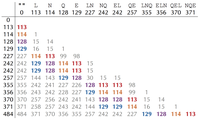July 29, 2015, 1:04 a.m. by Rosalind Team

We define the convolution of a cyclic spectrum by taking all positive differences of masses in the spectrum. Figure 1 shows the convolution of the theoretical spectrum of "NQEL".
As predicted, some of the values in Figure 2.12 appear more frequently than others. For example, 113 (the mass of "L") appears eight times in the convolution of the theoretical spectrum of "NQEL"; we say that 113 has multiplicity 8. Six of the eight occurrences of 113 correspond to subpeptide pairs differing in an "L": "L" and ""; "LN" and "N"; "EL" and "E"; "LNQ" and "NQ"; "QEL" and "QE"; "NQEL" and "NQE".
Compute the convolution of a spectrum.
Given: A collection of integers Spectrum.
Return: The list of elements in the convolution of Spectrum in decreasing order of their multiplicities. If an element has multiplicity k, it should appear exactly k times.
0 137 186 323
137 137 186 186 323 49